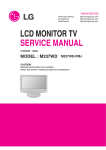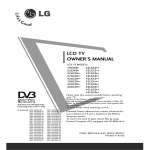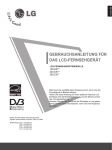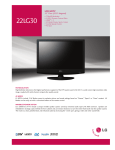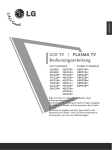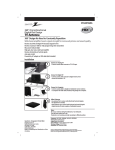Download Yamaha TX116 Service manual
Transcript
CONTENTS CONTENTS .............................................................................................. 2 SAFETY PRECAUTIONS ......................................................................... 3 SPECIFICATION ....................................................................................... 6 ADJUSTMENT INSTRUCTION ................................................................ 8 TROUBLE SHOOTING ........................................................................... 11 BLOCK DIAGRAM.................................................................................. 14 EXPLODED VIEW .................................................................................. 22 REPLACEMENT PARTS LIST ............................................................... 24 SVC. SHEET ............................................................................................... Copyright © 2008 LG Electronics. Inc. All right reserved. Only for training and service purposes -2- LGE Internal Use Only SAFETY PRECAUTIONS IMPORTANT SAFETY NOTICE Many electrical and mechanical parts in this chassis have special safety-related characteristics. These parts are identified by in the Schematic Diagram and Replacement Parts List. It is essential that these special safety parts should be replaced with the same components as recommended in this manual to prevent Shock, Fire, or other Hazards. Do not modify the original design without permission of manufacturer. Leakage Current Hot Check (See below Figure) Plug the AC cord directly into the AC outlet. General Guidance An isolation Transformer should always be used during the servicing of a receiver whose chassis is not isolated from the AC power line. Use a transformer of adequate power rating as this protects the technician from accidents resulting in personal injury from electrical shocks. It will also protect the receiver and it's components from being damaged by accidental shorts of the circuitry that may be inadvertently introduced during the service operation. If any fuse (or Fusible Resistor) in this TV receiver is blown, replace it with the specified. When replacing a high wattage resistor (Oxide Metal Film Resistor, over 1W), keep the resistor 10mm away from PCB. Do not use a line Isolation Transformer during this check. Connect 1.5K/10watt resistor in parallel with a 0.15uF capacitor between a known good earth ground (Water Pipe, Conduit, etc.) and the exposed metallic parts. Measure the AC voltage across the resistor using AC voltmeter with 1000 ohms/volt or more sensitivity. Reverse plug the AC cord into the AC outlet and repeat AC voltage measurements for each exposed metallic part. Any voltage measured must not exceed 0.75 volt RMS which is corresponds to 0.5mA. In case any measurement is out of the limits specified, there is possibility of shock hazard and the set must be checked and repaired before it is returned to the customer. Leakage Current Hot Check circuit Keep wires away from high voltage or high temperature parts. AC Volt-meter Before returning the receiver to the customer, always perform an AC leakage current check on the exposed metallic parts of the cabinet, such as antennas, terminals, etc., to be sure the set is safe to operate without damage of electrical shock. Leakage Current Cold Check(Antenna Cold Check) With the instrument AC plug removed from AC source, connect an electrical jumper across the two AC plug prongs. Place the AC switch in the on position, connect one lead of ohm-meter to the AC plug prongs tied together and touch other ohm-meter lead in turn to each exposed metallic parts such as antenna terminals, phone jacks, etc. If the exposed metallic part has a return path to the chassis, the measured resistance should be between 1MΩ and 5.2MΩ. When the exposed metal has no return path to the chassis the reading must be infinite. An other abnormality exists that must be corrected before the receiver is returned to the customer. Copyright © 2008 LG Electronics. Inc. All right reserved. Only for training and service purposes -3- To Instrument's exposed METALLIC PARTS Good Earth Ground such as WATER PIPE, CONDUIT etc. 0.15uF 1.5 Kohm/10W LGE Internal Use Only SERVICING PRECAUTIONS CAUTION: Before servicing receivers covered by this service manual and its supplements and addenda, read and follow the SAFETY PRECAUTIONS on page 3 of this publication. NOTE: If unforeseen circumstances create conflict between the following servicing precautions and any of the safety precautions on page 3 of this publication, always follow the safety precautions. Remember: Safety First. General Servicing Precautions 1. Always unplug the receiver AC power cord from the AC power source before; a. Removing or reinstalling any component, circuit board module or any other receiver assembly. b. Disconnecting or reconnecting any receiver electrical plug or other electrical connection. c. Connecting a test substitute in parallel with an electrolytic capacitor in the receiver. CAUTION: A wrong part substitution or incorrect polarity installation of electrolytic capacitors may result in an explosion hazard. 2. Test high voltage only by measuring it with an appropriate high voltage meter or other voltage measuring device (DVM, FETVOM, etc) equipped with a suitable high voltage probe. Do not test high voltage by "drawing an arc". 3. Do not spray chemicals on or near this receiver or any of its assemblies. 4. Unless specified otherwise in this service manual, clean electrical contacts only by applying the following mixture to the contacts with a pipe cleaner, cotton-tipped stick or comparable non-abrasive applicator; 10% (by volume) Acetone and 90% (by volume) isopropyl alcohol (90%-99% strength) CAUTION: This is a flammable mixture. Unless specified otherwise in this service manual, lubrication of contacts in not required. 5. Do not defeat any plug/socket B+ voltage interlocks with which receivers covered by this service manual might be equipped. 6. Do not apply AC power to this instrument and/or any of its electrical assemblies unless all solid-state device heat sinks are correctly installed. 7. Always connect the test receiver ground lead to the receiver chassis ground before connecting the test receiver positive lead. Always remove the test receiver ground lead last. 8. Use with this receiver only the test fixtures specified in this service manual. CAUTION: Do not connect the test fixture ground strap to any heat sink in this receiver. Electrostatically Sensitive (ES) Devices Some semiconductor (solid-state) devices can be damaged easily by static electricity. Such components commonly are called Electrostatically Sensitive (ES) Devices. Examples of typical ES devices are integrated circuits and some field-effect transistors and semiconductor "chip" components. The following techniques should be used to help reduce the incidence of component damage caused by static by static electricity. 1. Immediately before handling any semiconductor component or semiconductor-equipped assembly, drain off any electrostatic charge on your body by touching a known earth ground. Alternatively, obtain and wear a commercially available discharging wrist strap device, which should be removed to prevent potential shock reasons prior to applying power to the Copyright © 2008 LG Electronics. Inc. All right reserved. Only for training and service purposes unit under test. 2. After removing an electrical assembly equipped with ES devices, place the assembly on a conductive surface such as aluminum foil, to prevent electrostatic charge buildup or exposure of the assembly. 3. Use only a grounded-tip soldering iron to solder or unsolder ES devices. 4. Use only an anti-static type solder removal device. Some solder removal devices not classified as "anti-static" can generate electrical charges sufficient to damage ES devices. 5. Do not use freon-propelled chemicals. These can generate electrical charges sufficient to damage ES devices. 6. Do not remove a replacement ES device from its protective package until immediately before you are ready to install it. (Most replacement ES devices are packaged with leads electrically shorted together by conductive foam, aluminum foil or comparable conductive material). 7. Immediately before removing the protective material from the leads of a replacement ES device, touch the protective material to the chassis or circuit assembly into which the device will be installed. CAUTION: Be sure no power is applied to the chassis or circuit, and observe all other safety precautions. 8. Minimize bodily motions when handling unpackaged replacement ES devices. (Otherwise harmless motion such as the brushing together of your clothes fabric or the lifting of your foot from a carpeted floor can generate static electricity sufficient to damage an ES device.) General Soldering Guidelines 1. Use a grounded-tip, low-wattage soldering iron and appropriate tip size and shape that will maintain tip temperature within the range or 500°F to 600°F. 2. Use an appropriate gauge of RMA resin-core solder composed of 60 parts tin/40 parts lead. 3. Keep the soldering iron tip clean and well tinned. 4. Thoroughly clean the surfaces to be soldered. Use a mall wirebristle (0.5 inch, or 1.25cm) brush with a metal handle. Do not use freon-propelled spray-on cleaners. 5. Use the following unsoldering technique a. Allow the soldering iron tip to reach normal temperature. (500°F to 600°F) b. Heat the component lead until the solder melts. c. Quickly draw the melted solder with an anti-static, suctiontype solder removal device or with solder braid. CAUTION: Work quickly to avoid overheating the circuit board printed foil. 6. Use the following soldering technique. a. Allow the soldering iron tip to reach a normal temperature (500°F to 600°F) b. First, hold the soldering iron tip and solder the strand against the component lead until the solder melts. c. Quickly move the soldering iron tip to the junction of the component lead and the printed circuit foil, and hold it there only until the solder flows onto and around both the component lead and the foil. CAUTION: Work quickly to avoid overheating the circuit board printed foil. d. Closely inspect the solder area and remove any excess or splashed solder with a small wire-bristle brush. -4- LGE Internal Use Only IC Remove/Replacement Some chassis circuit boards have slotted holes (oblong) through which the IC leads are inserted and then bent flat against the circuit foil. When holes are the slotted type, the following technique should be used to remove and replace the IC. When working with boards using the familiar round hole, use the standard technique as outlined in paragraphs 5 and 6 above. Removal 1. Desolder and straighten each IC lead in one operation by gently prying up on the lead with the soldering iron tip as the solder melts. 2. Draw away the melted solder with an anti-static suction-type solder removal device (or with solder braid) before removing the IC. Replacement 1. Carefully insert the replacement IC in the circuit board. 2. Carefully bend each IC lead against the circuit foil pad and solder it. 3. Clean the soldered areas with a small wire-bristle brush. (It is not necessary to reapply acrylic coating to the areas). "Small-Signal" Discrete Transistor Removal/Replacement 1. Remove the defective transistor by clipping its leads as close as possible to the component body. 2. Bend into a "U" shape the end of each of three leads remaining on the circuit board. 3. Bend into a "U" shape the replacement transistor leads. 4. Connect the replacement transistor leads to the corresponding leads extending from the circuit board and crimp the "U" with long nose pliers to insure metal to metal contact then solder each connection. Power Output, Transistor Device Removal/Replacement 1. Heat and remove all solder from around the transistor leads. 2. Remove the heat sink mounting screw (if so equipped). 3. Carefully remove the transistor from the heat sink of the circuit board. 4. Insert new transistor in the circuit board. 5. Solder each transistor lead, and clip off excess lead. 6. Replace heat sink. Circuit Board Foil Repair Excessive heat applied to the copper foil of any printed circuit board will weaken the adhesive that bonds the foil to the circuit board causing the foil to separate from or "lift-off" the board. The following guidelines and procedures should be followed whenever this condition is encountered. At IC Connections To repair a defective copper pattern at IC connections use the following procedure to install a jumper wire on the copper pattern side of the circuit board. (Use this technique only on IC connections). 1. Carefully remove the damaged copper pattern with a sharp knife. (Remove only as much copper as absolutely necessary). 2. carefully scratch away the solder resist and acrylic coating (if used) from the end of the remaining copper pattern. 3. Bend a small "U" in one end of a small gauge jumper wire and carefully crimp it around the IC pin. Solder the IC connection. 4. Route the jumper wire along the path of the out-away copper pattern and let it overlap the previously scraped end of the good copper pattern. Solder the overlapped area and clip off any excess jumper wire. At Other Connections Use the following technique to repair the defective copper pattern at connections other than IC Pins. This technique involves the installation of a jumper wire on the component side of the circuit board. 1. Remove the defective copper pattern with a sharp knife. Remove at least 1/4 inch of copper, to ensure that a hazardous condition will not exist if the jumper wire opens. 2. Trace along the copper pattern from both sides of the pattern break and locate the nearest component that is directly connected to the affected copper pattern. 3. Connect insulated 20-gauge jumper wire from the lead of the nearest component on one side of the pattern break to the lead of the nearest component on the other side. Carefully crimp and solder the connections. CAUTION: Be sure the insulated jumper wire is dressed so the it does not touch components or sharp edges. Diode Removal/Replacement 1. Remove defective diode by clipping its leads as close as possible to diode body. 2. Bend the two remaining leads perpendicular y to the circuit board. 3. Observing diode polarity, wrap each lead of the new diode around the corresponding lead on the circuit board. 4. Securely crimp each connection and solder it. 5. Inspect (on the circuit board copper side) the solder joints of the two "original" leads. If they are not shiny, reheat them and if necessary, apply additional solder. Fuse and Conventional Resistor Removal/Replacement 1. Clip each fuse or resistor lead at top of the circuit board hollow stake. 2. Securely crimp the leads of replacement component around notch at stake top. 3. Solder the connections. CAUTION: Maintain original spacing between the replaced component and adjacent components and the circuit board to prevent excessive component temperatures. Copyright © 2008 LG Electronics. Inc. All right reserved. Only for training and service purposes -5- LGE Internal Use Only SPECIFICATION NOTE : Specifications and others are subject to change without notice for improvement. 1. Application range 3. Test method This specification is applied to the 19”/ 22” Wide LCD TV used LA85C chassis. 2. Requirement for Test 1) Performance: LGE TV test method followed 2) Demanded other specification - Safety: UL, CSA, IEC specification - EMC: FCC, ICES, IEC specification Model Each part is tested as below without special appointment. 19LG30-UA 1) Temperature: 20±5ºC 2) Relative Humidity: 65±10% 3) Power Voltage : Standard input voltage(100-240V~, 50/60Hz) * Standard Voltage of each product is marked by models 4) Specification and performance of each parts are followed each drawing and specification by part number in accordance with BOM. 5) The receiver must be operated for about 20 minutes prior to the adjustment. Market Appliance Central America Safety : UL1492, CSA C22.2.No.1 22LG30-UA EMC : FCC Class B, IEC Class B 4. General Specification(TV) No Item Specification Option 1 Receivable System ATSC/64 & 256 QAM/ NTSC-M 2 Available Channel VHF : 02 ~ 13 Remark USA only UHF : 14 ~ 69 DTV : 02 ~ 69 CATV : 01 ~ 135 CADTV : 01 ~ 135 3 Input Voltage 100-240V~, 50/60Hz 4 Market North and Central America 5 Screen Size 19/22 Inch 6 Aspect Ratio 16:9 7 Tuning System FS 8 LCD Module LM190WX1 (1440*900) Wide, LPL Not applied. M190A1-L07 (1440*900) Wide, CHI MEI 19LG30-UA (07.11.05) LM220WE1 (1680*1050) Wide, LPL 22LG30-UA M220Z1-L01 (1680*1050) Wide, CHI MEI Not applied. 9 Operating Environment Temp : 0 ~ 40 deg 10 Storage Environment Temp : -20 ~ 60 deg Humidity : ~ 80 % Humidity : 0 ~ 85 % Copyright © 2008 LG Electronics. Inc. All right reserved. Only for training and service purposes -6- LGE Internal Use Only 5. Component Video Input (Y, CB/PB, CR/PR) No H-freq(kHz) V-freq.(kHz) 1 2 720*480 720*480 Resolution 15.73 15.73 59.94 60.00 SDTV, DVD 480I(525I) SDTV, DVD 480I(525I) Proposed 3 4 720*480 720*480 31.47 31.50 59.94 60.00 SDTV 480P SDTV 480P 5 1280*720 44.96 59.94 HDTV 720P 6 7 1280*720 1920*1080 45.00 33.72 60.00 59.94 HDTV 720P HDTV 1080I 8 9 1920*1080 1920*1080 33.75 27 60.00 24 HDTV 1080I HDTV 1080P 10 1920*1080 33.75 30 HDTV 1080P 11 12 1920*1080 1920*1080 67.43 67.5 59.94 60 HDTV 1080P HDTV 1080P 6. RGB Input (PC) No Resolution PC H-freq(kHz) V-freq.(Hz) Pixel clock(MHz) Remark Proposed DDC 1 2 640*350 720*400 31.469 31.469 70.08 70.08 25.17 28.32 DOS DOS O 3 640*480 31.469 59.94 25.17 VESA(VGA) O 4 5 800*600 1024*768 37.879 48.363 60.31 60.00 40.00 65.00 VESA(SVGA) VESA(XGA) O O 6 7 1280*768 1360*768 47.776 47.712 59.87 60.01 79.50 85.50 VESA(WXGA) VESA(WXGA) O O 8 9 1440*900 1400*1050 55.5 64.744 59.90 59.948 88.750 101.00 22LG30-UA only WXGA WSXGA 10 1680*1050 62.290 59.954 146.25 22LG30-UA only WSXGA Remark 7. HDMI input (DTV) No Resolution PC H-freq(kHz) V-freq.(Hz) Pixel clock(MHz) 1 640*480 31.469 59.94 25.17 VESA(VGA) O 2 3 800*600 1024*768 37.879 48.363 60.31 60.00 40.00 65.00 VESA(SVGA) VESA(XGA) O O 4 5 1280*768 1360*768 47.776 47.720 59.87 59.799 79.50 84.75 CVT(WXGA) CVT(WXGA) O O 6 1440*900 55.5 59.90 88.750 19/22LG30-UA only WXGA 7 8 1400*1050 1680*1050 64.744 65.290 59.948 59.954 101.00 146.25 22LG30-UA only 22LG30-UA only WSXGA WSXGA 1 DTV 720*480 31.469 59.94 27.00 SDTV 480P 2 3 720*480 1280*720 31.500 44.96 60.00 59.94 27.03 74.17 SDTV 480P HDTV 720P 4 1280*720 45.00 60.00 74.25 HDTV 720P 5 6 1920*1080 1920*1080 33.72 33.75 59.94 60.00 74.17 74.25 HDTV 1080I HDTV 1080I 7 8 1920*1080 1920*1080 27 33.75 24.00 30.00 74.25 74.25 HDTV 1080P HDTV 1080P 9 1920*1080 67.43 59.94 148.35 HDTV 1080P 10 1920*1080 67.5 60.00 148.50 HDTV 1080P Copyright © 2008 LG Electronics. Inc. All right reserved. Only for training and service purposes -7- Proposed DDC LGE Internal Use Only ADJUSTMENT INSTRUCTION 1. Application Range (5) This specification sheet is applied for all of the LCD TV with LA85C chassis. filexxx.bin (7) ........ OK 2. Specification 1) The adjustment is according to the order which is designated and which must be followed, according to the plan which can be changed only on agreeing. 2) Power Adjustment : 100-240V~, 50/60Hz 3) Magnetic Field Condition : Nil. 4) Input signal Unit : Product Specification Standard 5) Reserve after operation : Above 30 Minutes 6) Adjustment equipments: Color Analyzer(CA-210 or CA110), Pattern Generator (MSPG-925L or Equivalent), DDC Adjustment Jig equipment, SVC remote control (6) 3.2. ADC Process 3.2.1. PC input ADC 3. Main PCB check process * APC - After Manual-Insult, executing APC 3.1. Software download 1) Execute ISP program “Mstar ISP Utility” and then click “Config” tab. 2) Set as below, and then click “Auto Detect” and check “OK” message. If display “Error”, Check connect computer, jig, and set. 3) Click “Connect” tab. If display “Can’t”, Check connect computer, jig, and set. (1) (3) <Adjustment pattern (PC)> Please Check Speed : To us speed between from 200 KHz to 400 KHz (2) (1) Auto RGB Gain/Offset Adjustment 1) Convert to PC in Input-source I2C COMMAND:0xF4(SELECT INPUT) 0x00 0x60(RGB) cf. 0x10(TV), 0x20(AV), 0x40(COMPONENT), 0x60(RGB), 0x90(HDMI) 2) Signal equipment displays Output Voltage : 700 mVp-p Impress Resolution XGA (1024x 768 @ 60Hz) Model : 60 in Pattern Generator Pattern : 29 in Pattern Generator (MSPG-925 Series) [gray pattern that left & right is black and center is white signal (Refer below picture)]. 3) Adjust by commanding AUTO_COLOR _ADJUST (0xF1) 0x00 0x02 instruction. OK 4) Click “Read” tab, and then load download file(XXXX.bin) by clicking “Read”. (4) * Manual ADC process using Service Remote control. After enter Service Mode by pushing “ADJ” key, execute “Autoadjust” by pushing “G” key at “0. ADC CALIBRATION”. filexxx.bin EZ ADJUST 0. ADC CALIBRATION : RGB 1. ADC ADJUST 2. SUB B/C ADJUST 3. W/B ADJUST 4. WHITE PATTERN : OFF 5. 2HOUR OFF : ON 6. OAD 7. UART DOWNLOAD 8. FACTORY MODE : ON 9. DEBUG MODE : OFF 5) Click “Auto” tab and set as below 6) click “Run”. 7) After downloading, check “OK” message. Copyright © 2008 LG Electronics. Inc. All right reserved. Only for training and service purposes (2) Confirmation 1) We confirm whether “0xB6” address of EEPROM “0xA2” is “0xAA” or not. 2) If “0xB6(RGB)” address of EEPROM “0xB2” isn’t “0xAA”, we adjust once more. 3) We can confirm the ADC values from “0xB0~0xB5 (RGB)” addresses in a page “0xA2” -8- LGE Internal Use Only 3.2.2. COMPONENT input ADC 3.3. Function Check (1) Component Gain/Offset Adjustment 1) Convert to Component in Input-source I2C command : 0xF4(Select input) 0x00 0x40(Component) cf. 0x10(TV), 0x20(AV), 0x40(COMPONENT), 0x60(RGB), 0x90(HDMI) 3.3.1. Check display and sound - Check Input and Signal items. (cf. work instructions) 1) TV 2) AV (CVBS/ S-Video) 3) COMPONENT (480i) 4) RGB (PC : 1024 x 768 @ 60hz) 5) HDMI 6) PC Audio In and H/P Out * Display and Sound check is executed by Remote control. <Adjustment pattern (COMPONENT)> 2) Signal equipment displays Impress Resolution 480i MODEL : 209 in Pattern Generator(480i Mode) PATTERN : 08 in Pattern Generator(MSPG-925 Series) 3) Adjust by commanding AUTO_COLOR_ADJUST (0xF1) 0x00 0x02 instruction. 4) Signal equipment display -Impress Resolution : 1080i - MODEL: 223 in Pattern Generator(1080i Mode) - PATTERN: 08 in Pattern generator(MAPG-925 series) 5) Adjust by commanding AUTO_COLOR ADJUST(0xF1) 0x00 0x02 instruction. * Manual ADC process using Service Remote control. After enter Service Mode by pushing “ADJ” key, execute “Autoadjust” by pushing “G” key at “0. ADC CALIBRATION”. EZ ADJUST 0. ADC CALIBRATION : COMPONENT 1. ADC ADJUST 2. SUB B/C ADJUST 3. W/B ADJUST 4. WHITE PATTERN : OFF 5. 2HOUR OFF : ON 6. OAD 7. UART DOWNLOAD 8. FACTORY MODE : ON 9. DEBUG MODE : OFF 4. Total Assembly line process 4.1. Adjustment Preparation 1) Heat-run above 30 minutes in RF no signal. 2) 15 Pin D-sub jack is connected to the auto W/B equipment. 4.2. Adjust color coordinate of Cool 1) Set Input to RGB. 2) Set Temperature : Cool 3) Adjust x=0.285±0.005, y=0.293±0.005 (9300ºK±1000ºK) or not. 4.3. Adjust color coordinate of Medium 1) Set Input to RGB. 2) Set Temperature : Medium 3) Adjust x=0.295±0.005, y=0.305±0.005 (8000ºK±1000ºK) or not. 4.4. Adjust color coordinate of Warm 1) Set Input to RGB. 2) Set Temperature : Warm 3) Adjust x=0.313±0.005, y=0.329±0.005 (8000ºK±1000ºK) or not. (2) Confirmation 1) We confirm whether “0xBF(480i)/0xC8(1080i)” address of EEPROM “0xA2” is “0xAA” or not. 2) If “0xBF(480i)/0xC8(1080i)” address of EEPROM “0xA2” isn’t “0xAA”, we adjust once more. 3) We can confirm the ADC values from “0xB9~0xBE(480i)/ 0xC2~(1080i)” addresses in a page “0xA2”. * Manual ADC Confirmation using Service Remocon. After enter Service Mode by pushing “INSTART” key. MODEL : 22LG30_UA_UA/LPL_LM220WT7 S/W VER : 3.00.1 UTT : 6 ADC CAL. RGB : OK YPbPr(SD) : OK YPbPr(HD) : OK 0. STEREO DETECT 1. SYNC LEVEL 2. DTV SNR 3. SCREEN MUTE 4. POWER OFF HISTORY Copyright © 2008 LG Electronics. Inc. All right reserved. Only for training and service purposes * Manual ADC Confirmation using Service Remocon. After enter Service Mode by pushing “INSTART” key. EZ ADJUST 0. ADC CALIBRATION : RGB 1. ADC ADJUST 2. SUB B/C ADJUST 3. W/B ADJUST 4. WHITE PATTERN : OFF 5. 2HOUR OFF : ON 6. OAD 7. UART DOWNLOAD 8. FACTORY MOD : ON 9. DEBUG MODE : OFF * Adjust “R/G/B - GAIN” by pushing “F”, “G” key at “Cool” * Adjust “R/G/B - GAIN” by pushing “F”, “G” key at “Medium” * Adjust “R/G/B - GAIN” by pushing “F”, “G” key at “Warm” -9- LGE Internal Use Only 4.6. HDCP setting W/B ADJUST 0. MODE : RGB 1. WHITE PATTERN : White 2. TEMPERATURE : Cool 3. R - GAIN : 128 4. G - GAIN : 128 5. B - GAIN : 128 6. R – OFFSET : 128 7. G – OFFSET : 128 8. B – OFFSET : 128 9. RESET (High-Bandwidth Digital Contents Protection) 1) Connect D-sub Signal Cable to D-Sub Jack. 2) Input HDCP key with HDCP-key- in-program. 3) HDCP Key value is stored on EEPROM(AT24C512) which is 80~A1 addresses of 0xA0~0xA2 page 4) AC off/ on and on HDCP button of MSPG925 and confirm whether picture is displayed or not of using MSPG925 5) HDCP Key value is different among the sets. 4.5. DDC EDID WRITE 1) Connect D-sub Signal Cable to D-Sub Jack. 2) Connect HDMI Signal Cable to HDMI Jack. 3) Write EDID DATA to EEPROM (24C02) by using DDC2B protocol. 4) Check whether written EDID data is correct or not. (Refer to Product spec). 5) Remark : A week manufacture in address 0x10 can be changed. And thus Checksum (Address: 0x7F) can be also changed. 4.5.1. 19LG30 EDID DATA (1) ANALOG DATA 128Byte - Remark: A week manufacture in address 0x10 can be changed. And thus Checksum (Address: 0x7F) can be also changed. (2) DIGITAL DATA 256Byte - Remark: A week manufacture in address 0x10 can be changed. And thus Checksum (Address: 0x7F) can be also changed. 1) All Data : HEXA Value 2) Changeable Data : *: Serial No : Controlled / Data:01 **: Month : Controlled / Data:00 ***:Year : Controlled ****:Check sum Copyright © 2008 LG Electronics. Inc. All right reserved. Only for training and service purposes - 10 - LGE Internal Use Only TROUBLE SHOOTING 1. No Power (LED indicator off) Start check Fail Check 15V or 5V of P701. Check short of Main board or change LIPS. Pass Pass Pass Check Output of IC705. Check output of Q701. Fail Change Q701. Fail Change IC705. Pass Fail Check LED Assy. Change LED Assy. Pass Check P304 & Connector. Copyright © 2008 LG Electronics. Inc. All right reserved. Only for training and service purposes - 11 - LGE Internal Use Only 2. No RASTER Start check Check LED status On Display Unit. Fail Repeat No power (1) PROCESS. Pass Check IC700, IC702, IC703, IC704, IC705, IC706, IC708, IC709, IC710. Fail Change IC700, IC702, IC703, IC704, IC705, IC706, IC708, IC709, IC710. Pass Check input/output of IC00. Fail Change IC100 Pass Check the inverter connector or inverter. Fail Change inverter connector or inverter Pass Check LVDS cable or module. Fail Change LVDS cable or module. Pass Check input source cable & jack. Copyright © 2008 LG Electronics. Inc. All right reserved. Only for training and service purposes - 12 - LGE Internal Use Only 3-1. No Raster on AV signal (AV/ COMPONENT/ S-VIDEO RGB-PC) 3-2. NO Raster on RF signal (TV) Start Check 3-1 Start Check 3-2 Pass Pass Fail Repeat No power(1) process. Check output of TU400. Pass Check the signal of R622, R623, R681, R615, R616, R617, R640,R641, R642. Fail Check 5V of TU400. Re-Soldering or change the defect part. Pass Fail Change signal of R622, R623, R681, R615, R616, R617, R640,R641,R642. Pass Check input/output of IC100. Fail Re-soldering or change defect part. Check X100. Pass Check input source cable and jack. Copyright © 2008 LG Electronics. Inc. All right reserved. Only for training and service purposes - 13 - LGE Internal Use Only 4. No sound Start Check Check the input Source. Fail Change source input. Pass Check input/Output of IC100. Fail Re-soldering or change the defect part. Check the X100. Fail Re-soldering or change the defect part. Pass Check the input/ output of IC500. Pass Fail Check the Speaker. Change the speaker. Pass Check the Speaker wire. Copyright © 2008 LG Electronics. Inc. All right reserved. Only for training and service purposes - 14 - LGE Internal Use Only [3] [N:11] [P:10] SCL[8] [12] Copyright © 2008 LG Electronics. Inc. All right reserved. Only for training and service purposes 1.0Vp-p 96dBuV [16] [15] SDA[7] - 15 - EAG31022001 USB(SVC only) 6630G00001A RS232C(SVC only) 6612F00099A PC Audio IN 6630G70016A PC(VGA) 6612J10031C Tx_Out IF-P IF-N SIF TPA6110A20 Tx/Rx EAN41348201 ST-5V R232C_Tx R232C_Rx ST-5V HPDCTRL[12] PC IN Comp1 DDC_SDA/UART_TX12V DDC_SCL/UART_RX HP_L/r[70,71] TXCLK-[2] TXCLK+[3] IN1 IN1 SIFP0 SIFM0 TUNER_CVBS VCOM0 1.25V 3.3V LVDS(8Bit) HY5DU561622F 256M (DDR) HY5DU561622F 256M (DDR) 2.5V VDD_DDR 3.3V AVDD_DVI OUT_P_R[8] OUT_N_R[14] OUT_P_L[35] OUT_N_L[29] (YDA148-EZ) EAN40130001 D-AMP MUTE[6] Audio_R IN_R[5] HP_DET[37] IN_L[38] Audio_L LGE1854C L OUT R OUT CVBS1[42] AUL_IN0[54] AUR_IN[55] AV1_SW[111] SV_C0[38] SV_Y0[39] MSTAR S_SW[82] EAN37156404SCL_EEPROM[136] SDA_EEPROM[135] B_TX0-[4] Air : 8VSB EEPROM(512K) EEPROM(512K) B_TX0+[5] 24C512 Cable : 256/64QAM 24C512 G_TX1-[7] •RGB/YPbYr*2 G_TX1[8] 0IMMRAL025A R_TX2-[10] •CVBS*3 SPI_CK[129] R_TX2+[11] SPI_DI[130] PB_IN[26] •YC*2 Flash Flash(64M) (64M) SPI_DO[131] SOY[29] •L/R-IN*3 S25FL064A S25FL064A SPI_CZ[132] Y_IN[28] •SIF PR_IN[31] SAR3[121] EAN42961201 AUL_IN1[56]•CVBS OUT*1 SAR2[120] AUR_IN1[57]•HDMI*1 SAR1[119] KEY_CTL[1,2] COMP_SW[112] SAR0[118] BIN[21]SOGIN[22]GIN[23]RIN[24] IR_RX[114] VS_RGB[17] HS_RGB[16] RGB_SW[80] SCL/RX[117] SDA/TX[116] AUOUTL0[72] AUOUTR0[73] GPIO12[79] SIFP0[51] VCOM0[45] CVBS0[44] SIFM0[50] 1CH LVDS[137-146] 2CH LVDS[137-146, 150-159] RXE/RXO TS0-7[86,87,88,89,90,91,92,93] IN[255] OUT[254] MSCL SCLM1[127] MSDA SDAM1[126] TSCLK[96] TSSYNC[95] TSVALID[94] TP DATA[0-7] DDCDA_SDA[14] DDCDA_SCL[15] POWER_HDMI[110] Video/Audio SW Buffer Buffer TPVALID[19] TPERR[17] 0ICTMLG019C TPSOP[34] (LGDT3304) SDA_TU[13] TPCLK[33] MAX3232CDR USB_DM[251] USB_DP[252] USB_OCD_N[83] IN[55] OUT[54] VSB/QAM [20,22,24,26, 27,28,29,31] SCL[38] Receiver SCL_TU[11] SDA[36] IFP[3] IFN[4] 12MHz 2 6212AB2872A 2 X100 1.2V 3.3V CLK_ 25MHz IFAGC[22] OP-AMP CVBS(ATV) IF_AGC 2 EEPROM EAN35989901 Rx_In AUR_IN[59] AUL_IN[58] 6612F00001D Comp_1 YPbPr/LR Head Phone 5V YC EAG35541101 EEPROM EAN35989901 6612B00015C 6612B00015C HDMI Rear S_1 Rear AV_1 V, LR EAG35541101 ATSC/NTSC Tuner (TDVF-H051F) LG Innotek 5V AIR CABLE L C D Power 15V/ST-5V 19”/22 ” Power/LIPS 3.3V 3.3V G-5V BLOCK DIAGRAM 1. Main LGE Internal Use Only 2 15V Copyright © 2008 LG Electronics. Inc. All right reserved. Only for training and service purposes ST5V ST15V From LIPs (19” ,22 ” W) INV_BR 11 DIM 10 INV_CTL 9 NC 8 GND 7 ST5V 6 ST5V 5 GND 4 GND 3 1 15V - 16 5V Q704 FET (SI49258 ) IC708 SC4215ISTRT 3.3V IC704 AZ1085S-3.3 IC600 CAT24C02WI IC705 AZ1085S-ADJ IC709 AZ1085S-ADJ IC703 AZ1085S-3.3 IC706 AZ1117H-3.3 IC700 KIA7809F IC702 MP2305DS 1.2V 3.3V ST3.3V ST2.6V ST3.3V ST3.3V 9V 12V Pannel 19”, 22” IC800 CAT24C02WI VDD AVDD VDD33 AVDD33 IC400 LGDT3304 IC200 / IC201 SDRAM *2 HY57V641620ETP IC710 AZ1085S-ADJ IC701 KIA7805F ST1.25V 5V IC601 MAX3232CDR IC104 MC74LCX140I IC102 AT24C512W IC103 / IC105 Flash Memory IR receiver IC501 HP Amp (TPA6110A) VDDP AVDD_OTG VDD_DDR LGE1854C AVDD_ADC, AVDD_SIF AVDD_AU , AVDD_MemPLL AVDD_MPLL, AVDD_LPLL AVDD_DVI, AVDD_XTAL AVDD_DVI IC100 VDDC TU400 TUNER (TDVF-H051F) IC500 Sound Amp (YDA148) 2. POWER LGE Internal Use Only Copyright © 2008 LG Electronics. Inc. All right reserved. Only for training and service purposes - 17 - CVBS[16] SIF[15] AS[9] TDVFH051F SDA[7] SCL[8] IF_AGC[12] IF1[10] IF1[11] B+[3] Buffer IF_AGC IF_P IF_N 64Kbyte TUNER_CVBS SIF LPF TS[20,22,24,26, 27,28,29,31] TU_SDA[13] TU_SCL[11] MSDA[36] MSCL[38] IF_AGC[15] TS_VALID TS_CLK TS_SYNC TS[0-7] I2C MSCL / MSDA TS_CLK[33] TS_SYNC[34] TS_VALID[19] LGDT3304 [8VSB,QAM] IF_N[4] IF_P[3] DDC_I2C E2PROM_I2C CVBS_0 SIF MAIN I2C TS_DATA [MSTAR] LGE1854C E2PROM EDID / ISP 3. TUNER + VSB LGE Internal Use Only Copyright © 2008 LG Electronics. Inc. All right reserved. Only for training and service purposes Audio path Video path - 18 DSUB RGB_L/R COMPONENT_L/R AV1_L/R SIF HDMI_DATA TS_DATA HDMI RGB Component S-Video AV AU_OUT0_ L/R LGE1854C LGDT3304 (From Tuner) LGE1854C TS Data HDMI RGB [TPA6110A] Head Phone AMP [YDA148] CLASS-D AMP Head Phone Output SPEAKER Output Component ( Y/ Cb/Cr ) SVIDEO ( Y/C ) CVBS1 CVBS0 YAMAHA DTV_IN HDMI_DATA RGB_IN Y/Cb/Cr_IN Y/C IN CVBS1 AT_TU_V 4. VIDEO, AUDIO LGE Internal Use Only Copyright © 2008 LG Electronics. Inc. All right reserved. Only for training and service purposes - 19 - SDA[7] SCL[8] TU400 TUNER IC600 24C02 [EDID] IC800 24C02 [EDID] DDC_SCL DDC_SDA JK605 D-SUB DDCDA_SDA DDCDA_SCL MSDA SDA [36] MSCL SCL [38] IC400 LGDT3304 SCL_HDMI SDA_HDMI SDA_TU SCL_TU J800 HDMI IC102 24C512 SCL SDA SCL_EEPROM [136] SDA_EEPROM [135] IC103/IC105 Flash Memory SPI_CK SPI_DI SPI_DO SPI_CZ SCK [129] SDI [130] SDO [131] SCZ [132] IC100 LGE1854C DDCDA_DA [14] DDCDA_CK [15] DDCR_DA [126] DDCR_CK [127] DDCA_SC [116] DDCA_DA [117] UART_TX1 [196] UART_RX1 [195] AR[0:12] MDATA[16:31] DQM0/1 CKE MCLK AR[0:12] MDATA[0:15] DQM0/1 CKE MCLK RS232C_TXD RS232C_RXD IC601 MAX3232CDR JK606 RS232C IC201 SDRAM IC200 SDRAM 5. CONTROL LGE Internal Use Only Copyright © 2008 LG Electronics. Inc. All right reserved. Only for training and service purposes - 20 - SCK SDI SDO CSZ IC100 [LGE1854C] DDC_ROM SCL/SDA MSCL/MSDA IC100 [LGE1854C] I2C_5V SPI_CK SPI_DI SPI_DO SPI_CSZ ST3.3V /5V 5VST SCLK SI SO S25PFL064A or MX25L64050MI CS# [Serial Flash] EEPROM EEPROM (EDID) (EDID) IC102, IC102, IC600,IC800 IC600,IC800 LGDT3304 TUNER 0xA0 0x1C 0xC2 I2C Address 6. I2C LGE Internal Use Only MEMO Copyright © 2008 LG Electronics. Inc. All right reserved. Only for training and service purposes - 21 - LGE Internal Use Only 521 920 500 501 300 123 122 120 200 530 540 LV1 820 910 900 510 511 400 410 EXPLODED VIEW Copyright © 2008 LG Electronics. Inc. All right reserved. Only for training and service purposes - 22 - LGE Internal Use Only Copyright © 2008 LG Electronics. Inc. All right reserved. Only for training and service purposes LGE Internal Use Only Copyright © 2008 LG Electronics. Inc. All right reserved. Only for training and service purposes LGE Internal Use Only P/NO : MFL41524412 Mar., 2008 Printed in Korea


























